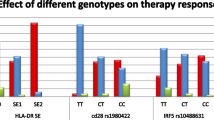Abstract
This study analyses the prognostic value of HLA-DRB 1 genes for Swiss patients with rheumatoid arthritis (RA). HLA-DRB 1 genotyping was performed in 83 patients using the polymerase chain reaction and subsequent oligonucleotide hybridisation. They were categorised according to the presence of one or two putatively relevant genes (DRB 1*01 and/or DRB 1*04) and retrospectively evaluated for sex, age at disease onset, seropositivity, erosive disease and extraarticular manifestations. Sixty-one patients (73%) had disease-associated alleles. Twenty-four patients showed HLA-DRB 1*04 variants on both alleles or combined an HLA-DRB 1*04 variant with HLA-DRB 1*01, while 37 patients expressed only one relevant allele. Interestingly, 22 patients did not express any relevant allele. Some 52% of patients had nodular disease, 88% were seropositive, 96% had joint erosions and I I% expressed vasculitis and/or rheumatoid organ disease. A significant difference was observed only for the number of seropositive individuals, which was slightly higher in the group of patients expressing a double dose of disease-associated alleles than in patients who had no relevant alleles. Moreover, patients expressing homozygous DRB 1 alleles had a significantly earlier onset of disease than those who were heterozygous. We conclude from these findings that HLA-DRB 1 genotyping in a Swiss population of RA patients only weakly identifies clinical subsets with distinct profiles of disease manifestations and is not of strong prognostic value to determine disease severity in individual patients.
Similar content being viewed by others
References
Stastny P (1974) Mixed lymphocyte culture typing cells from patients with rheumatoid arthritis. Tissue Antigens 4:571–579
Stastny P (1978) Associations of the B-cell alloanfigen DRw4 with rheumatoid arthritis. N Engl J Med 298:869–871
Wordsworth BP, Lanchbury JSS, Sakkas LI, Welsh KI, Panayi G, Bell JI (1989) HLA DR4 subtype frequency in rheumatoid arthritis indicates that DRbeta 1 is the major susceptibility locus within the human leukocyte antigen class two region. Proc Natl Acad Sci USA 86:10049–10053
Pile K, Gibson K, Jessop J, Camilleri JK, Emberton R, Wordsworth P (19939 HLA-DR 4 subtyping by single-strand polymorphism analysis. Lancet 342: 300–301
Gregersen PK, Dilver J, Winchester RJ (1989) The shared epitope hypothesis: an approach to understanding the molecular genetics of susceptibility to rheumatoid arthritis. Arthritis Rheum 30:1205–1213
Wordsworth BP, Stedeford J, Rosenberg WMC, Bell JI (1991) Limited heterogeneity of the HLA class II contribution to susceptibility to rheumatoid arthritis is suggested by positive associations with HLA DR 4, DR 1 and DRw 10. Br J Rheumatol 30:178–180
Weyand CM, Xie CP, Goronzy JJ (1992) Homozygosity for the HLA-DRB 1 allele selects for extraarticular manifestations in rheumatoid arthritis. J Clin Invest 89:2033–2039
Weyand CM, Hicock KC, Conn DL, Goronzy JJ (1992) The influence of HLA-DRB 1 genes on disease severity in rheumatoid arthritis. Ann Int Med 117:801–806
Gough A, Faint J, Salmon M, Hassell A, et al. (1994) Genetic typing of patients with inflammatory arthritis at presentation can be used to predict outcome. Arthritis Rheum 37:1166–1170
Swiss Federal Commission for the Rheumatic Diseases (1986) HLA-DR antigens in rheumatoid arthritis. Rheumatol Int 6:89–92
Arnet FC, Edworthy SM, Bloch DA, et al (1988) The American Rheumatism Association 1987 revised criteria for the classification of rheumatoid arthritis. Arthritis Rheum 31:312–324
Gustincich S, Manfiolet G, del Sal G, et al (1991) A fast method for high-quality genomic DNA extraction from whole human blood. Biotechniques 11:298–302
Tiercy JM, Grundschober C, Jeannet M, et al (1993) A comprehensive HLA-DRB, -DQB and -DPB oligotyping procedure by hybridization with sequence-specific oligonucleotide probes. In: Handbook of HLA typing techniques. CRC Press, Boca Ration, pp 117–147
Olerup O, Zetterquist H (1992) HLA-DR typing by PCR amplification with sequence-specific primers (PCR-SSP) in 2 hours. Tissue Antigens 39:225–235
Van Zeben D, Hazes JMW, Zwinderman AH, Cats A, Schreuder GMT, et al (1991) Association of HLA-DR4 with a more progressive disease course in patients with rheumatoid arthritis: results of a follow-up study. Arthritis Rheum 34:822–830
Mitchell D (1985) Epidemiology. In: Utsiger PD, Zvaifler NJ, Ehrlich GE (eds) Rheumatoid arthritis. Etiology, diagnosis, management. Lippincott, Philadelphia, pp 133–150
Möttönen TT (1988) Prediction of erosiveness and rate of development of new erosions in early rheumatoid arthritis. Ann Rheum Dis 47:648–653
Author information
Authors and Affiliations
Rights and permissions
About this article
Cite this article
Seitz, M., Perler, M. & Pichler, W. Only weak association between disease severity and HLA-DRB 1 genes in a Swiss population of rheumatoid arthritis patients. Rheumatol Int 16, 9–13 (1996). https://doi.org/10.1007/BF01419948
Received:
Accepted:
Issue Date:
DOI: https://doi.org/10.1007/BF01419948




